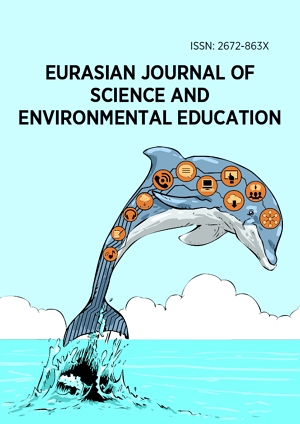Research Article
The Effect of Mind-Mapping on the Memorization and Acquisition of Immunology Concepts in the Secondary School
More Detail
1 LIRIP, ENS, Abdemalek Essaadi University, Tetouan, MOROCCO2 Department of Molecular Biosciences, College of Natural Sciences, The University of Texas at Austin, Austin, TX, USA* Corresponding Author
Eurasian Journal of Science and Environmental Education, 2(1), June 2022, 11-19, https://doi.org/10.30935/ejsee/12165
Published: 16 June 2022
OPEN ACCESS 1776 Views 1334 Downloads
ABSTRACT
The majority of students do not want to learn with traditional methods and practices; they have found it difficult to recall knowledge presented in the classroom. Teaching and learning practices in secondary school do not facilitate the success of all students who have few opportunities to develop a good understanding and memorization of scientific concepts. In fact, teachers and researchers have the opportunity to identify and research alternatives to traditional practices. The aim of the current study is to highlight the impact of using mind-mapping on the memorization and acquisition of immunology concepts in secondary school and to evaluate its effectiveness as a teaching-learning practice. We assigned a quiz to 40 secondary school students in order to measure their memorization and acquisition, and used five mind-maps regarding the immunology concepts in the teaching process for the experimental group. We analyzed all the student’s scores obtained in the quiz, and we found that the experimental group had a good understanding and memorization regarding immunology concepts and had more success than the control group in the quiz. However, we found that mind-mapping has a more important impact on the memorization and acquisition of immunology concepts in secondary school.
CITATION (APA)
Zghida, N. E., Janati-Idrissi, R., Rengasamy, R. P. M., & Sinan, O. (2022). The Effect of Mind-Mapping on the Memorization and Acquisition of Immunology Concepts in the Secondary School. Eurasian Journal of Science and Environmental Education, 2(1), 11-19. https://doi.org/10.30935/ejsee/12165
REFERENCES
- Adodo, S. O. (2013). Effect of mind-mapping as a self-regulated learning strategy on students’ achievement in basic science and technology. Mediterranean Journal of Social Sciences, 4(6), 163-172. https://doi.org/10.5901/mjss.2013.v4n6p163
- Bransford, J. D., Brown, A. L., & Cocking, R. R. (Eds.). (2000). How people learn: Brain, mind, experience, and school. The National Academies Press.
- Budd, J. W. (2004). Mind maps as classroom exercises. The Journal of Economic Education, 35(1), 35-46.https://doi.org/10.3200/JECE.35.1.35-46
- Buzan, T. (2000). Head first: 10 ways to tap into your natural genius. Thorsons.
- Buzan, T. (2005). Mind map handbook. Thorsons.
- Buzan, T., & Buzan, B. (1993). The mind map book: How to use radiant thinking to maximize your brain’s untapped potential. Penguin Group.
- Buzan, T., & Buzan, B. (1997). The mindmap book:[radiant thinking; the major evolution in human thought]. BBC Books.
- Cawelti, G. (1997). Effects of high school restructuring: Ten schools at work. Educational Research Service.
- Dhindsa, H. S., Makarimi-Kasim, & Roger Anderson, O. (2011). Constructivist-visual mind map teaching approach and the quality of students’ cognitive structures. Journal of Science Education and Technology, 20, 186-200. https://doi.org/10.1007/s10956-010-9245-4
- Ettinger, J. (1998). Shaping tomorrow’s workforce today. High School Magazine, 5, 26-31.
- Fogarty, R., & Bellanca, J. (1995). Cognition in practice. In R. Fogarty (Ed.), Best practices for the learner centered classroom (pp. 73-100). IRI/Skylight Training and Publishing, Inc.
- Gardner, H. (1985). Frames of mind: The theory of multiple intelligences. Basic Books, Inc.
- Gardner, H. (1999). Intelligence reframed: Multiple intelligences for the 21st century. Basic Books, Inc.
- Given, B. K. (2002). Teaching to the brain’s natural learning systems. Association for Supervision and Curriculum Development.
- Glickman, C. (1991). Pretending not to know what we know. Educational Leadership, 48(8), 4-10.
- Hyerle, D. (1996). Visual tools for constructing knowledge. Association for Supervision and Curriculum Development.
- Jackson, A. W., & Davis, G. A. (with Abeel, M., & Bordonaro, A.) (2000). Turning points 2000: Education adolescents in the 21st century. Teachers College Press.
- Lewis, C. (1997). Mind mapping—its benefits for trainers. Training Officer, 33(9), 278-279.
- Longley, P. A., Goodchild, M. F., Maguire, D. J., & Rhind, D. W. (2001). Geographic information systems and science. John Wiley & Sons, Ltd.
- Margulies, N. (1991). Mapping inner space: Learning and teaching mind mapping. Zephyr Press.
- Mayer, R. E. (1998). Cognitive theory for education: What teachers need to know. In N. M. Lambert, & B. L. McCombs (Eds.), How students learn: Reforming schools through learner-centered education (pp. 353-377). American Psychological Association. https://doi.org/10.1023/A:1018794104325
- Mona, I., & Adbkhalick, F. (2008). The influence of mind mapping on eighth graders’ science achievement. School Science and Mathematics, 108(7), 298312. https://doi.org/10.1111/j.1949-8594.2008.tb17843.x
- Texley, J., & Wild, A. (Eds.). (1996). NSTA pathways to the science standards: Guidelines for moving the vision into practice. National Science Teachers Association.
- Wandersee, J. H. (1990). Concept mapping and the cartography of cognition. Journal of Research in Science Teaching, 27(10), 923-936. https://doi.org/10.1002/tea.3660271002
- Wycoff, J. (1991). Mind mapping: Your personal guide to exploring creativity and problem-solving. Berkley Books.
- Wycoff, J. (1995). Transformation thinking. Berkley Books.

 The articles published in this journal are licensed under the CC-BY Creative Commons Attribution International License.
The articles published in this journal are licensed under the CC-BY Creative Commons Attribution International License.